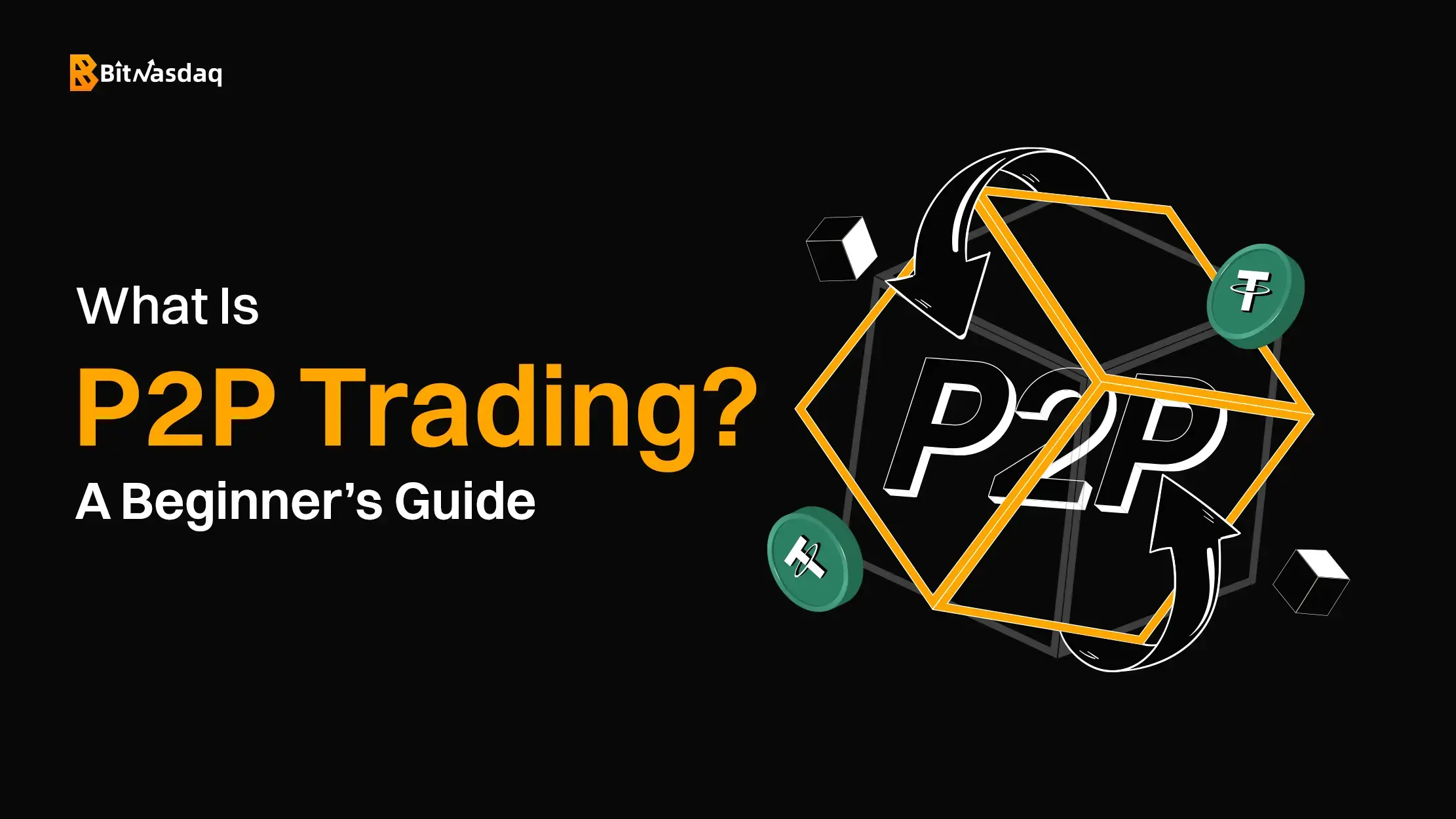What Is P2P Trading? A Beginner’s Guide
2025-02-05 06:19:23

Peer-to-peer Trading, P2P Trading, allows individuals to exchange assets directly without intermediaries. This method ensures greater control and transparency in transactions. Common in cryptocurrency exchanges, P2P Trading offers flexibility in terms of payment options, pricing, and user preferences. It's a growing trend for users seeking privacy, reduced fees, and enhanced security. By understanding its fundamentals, anyone can explore this decentralized trading model to engage effectively and benefit from its unique advantages.
Understanding Peer-To-Peer Trading

Peer-to-peer, P2P, trading revolutionizes traditional exchange systems by connecting buyers and sellers directly. In centralized exchanges, an intermediary manages transactions, P2P Trading platforms act as facilitators. These platforms provide a secure environment, with escrow services, to ensure smooth exchanges. Users enjoy flexibility in payment methods, enhanced privacy, and the ability to negotiate directly with counterparties.
P2P Trading is particularly popular in the cryptocurrency market. It empowers users to trade USDT, Bitcoin, Ethereum, and other digital assets with minimal interference. This approach benefits users in regions with strict banking regulations or limited access to financial services. Additionally, the decentralized nature of P2P Trading creates a sense of community and trust among participants.
For beginners, understanding the nuances of P2P Trading is crucial. Factors like platform reputation, transaction security, and choosing the right counterparties can significantly impact the experience. With proper knowledge, users can navigate this innovative trading model confidently, enjoying its numerous advantages over traditional systems.
What Is P2P Trading, The Basics
P2P Trading involves direct transactions between buyers and sellers without relying on centralized intermediaries. In this setup, platforms facilitate connections and provide tools like escrow services to enhance security. Users negotiate terms, select preferred payment methods, and complete trades transparently. This trading approach is especially popular in cryptocurrency markets, offering lower fees and greater control. By bypassing traditional exchange structures, P2P Trading creates financial inclusivity and convenience for global users.
How Peer-To-Peer Trading Differs From Traditional Methods
Peer-to-peer trading eliminates the need for intermediaries, allowing direct asset exchanges. Unlike traditional methods where centralized entities oversee transactions, P2P Platforms only facilitate connections and provide escrow services for security. This ensures lower costs and faster processing times. Additionally, P2P Trading offers enhanced privacy, as users directly negotiate terms. These distinctions make it ideal for cryptocurrency users seeking control, transparency, and global access compared to traditional systems.
How Does P2P Trading Work?

P2P Trading operates through decentralized and centralized platforms that connect buyers and sellers directly. Users create listings specifying their trading terms, including asset type, price, and payment method. Interested parties can browse these listings, negotiate, and initiate transactions. To ensure security, platforms offer escrow services, holding assets until both parties fulfill their obligations. This P2P Trading method bypasses intermediaries, reducing costs and enhancing privacy. It’s an efficient model for transparent and secure trading in digital markets.
The Mechanics Of P2P Trading
The mechanics of P2P Trading revolve around direct interactions between participants. A typical transaction involves the seller listing their asset with specific terms, such as price and payment options. Buyers can browse and select suitable offers. Once both parties agree, the platform';s escrow service holds the asset securely until the transaction is complete. This ensures fairness and minimizes risks. By enabling decentralized exchanges, P2P Trading empowers users with control and transparency.
P2P Cryptocurrency Exchange, Key Features
P2P cryptocurrency exchanges offer unique features that set them apart. Users enjoy direct trades with customizable terms, enabling control and flexibility. Platforms often include escrow services to ensure secure transactions. Multiple payment options, including local and global methods, enhance accessibility. P2P exchanges prioritize user privacy by minimizing data sharing. They also cater to diverse needs, supporting various cryptocurrencies. These features make P2P platforms an attractive choice for decentralized and secure trading experiences.
How P2P Trading Fits Into The Crypto Landscape
P2P Trading complements the crypto ecosystem by embodying decentralization. It provides an alternative to centralized exchanges, aligning with blockchain's ethos of user empowerment. P2P platforms cater to underserved regions with limited financial access, offering inclusivity. They also address privacy concerns by enabling direct, confidential transactions. As cryptocurrencies gain traction, P2P Trading reinforces their adoption, bridging gaps in accessibility while maintaining the principles of transparency, control, and innovation in digital finance.
Choosing The Right P2P Cryptocurrency Exchange
Selecting the right P2P cryptocurrency exchange involves evaluating key factors. Platform reputation is crucial, trusted exchanges ensure security and reliability. Features like escrow services, payment flexibility, and user-friendly interfaces enhance the trading experience. It's essential to consider supported cryptocurrencies and regional accessibility. Additionally, user reviews and customer support quality offer insights. By assessing these elements, traders can identify platforms that align with their preferences for safe and efficient P2P Trading.
Benefits Of P2P Trading

There are many benefits of P2P Trading. The benefits P2P Trading offers make it a preferred choice for many. Users enjoy lower fees, as there are no intermediaries involved. The decentralized nature ensures enhanced privacy, with transactions conducted directly. Flexibility in payment options and customizable trading terms empower users. Additionally, P2P Trading creates global accessibility, connecting participants across borders. This approach not only democratizes trading but also aligns with the principles of decentralization, transparency, and user control in digital finance.
No Fee And Better Rates With BitNasdaq
BitNasdaq P2P Trading platform eliminates traditional fees, offering cost-effective solutions. Users benefit from competitive rates through direct negotiations, bypassing centralized pricing controls. This ensures optimal value for both buyers and sellers. The platform's commitment to transparency enhances trust, while its user-friendly interface simplifies trading. With no hidden charges and better rates, BitNasdaq positions itself as a leading choice for simple and economical P2P cryptocurrency exchanges.
Greater Privacy In Direct Trading
P2P Trading prioritizes user privacy by minimizing third-party involvement. Transactions occur directly between participants, reducing the need for extensive personal data sharing. Platforms like BitNasdaq enhance this by incorporating secure protocols and optional anonymity features. This approach ensures confidentiality while maintaining transparency in transaction records. For users seeking discretion and control over their financial activities, P2P Trading provides an ideal solution, aligning with privacy-focused principles in the crypto space.
P2P Trading In Centralized Trading

P2P Trading and centralized trading differ significantly in approach and benefits. P2P platforms connect buyers and sellers directly, ensuring flexibility, privacy, and lower fees. Centralized exchanges, in contrast, offer high liquidity and advanced tools but involve intermediaries and fees. P2P Trading aligns with decentralization, empowering users with control. The choice depends on individual priorities like cost-effectiveness and privacy in P2P Trading versus efficiency and features in centralized systems.
When we talk about P2P Trading in Centralized Trading, we see that it bridges the gap between P2P Trading and decentralization of asset exchange. This makes P2P Trading an ideal option for those looking for transparency in trading at lower costs and personalization.
Pros And Cons Of Peer-To-Peer Trading
P2P Trading offers advantages like reduced fees, enhanced privacy, and flexible payment options. It's accessible globally and aligns with decentralization principles. However, it also has drawbacks, including lower liquidity compared to centralized exchanges and potential risks from fraudulent counterparties. Choosing a reputable platform, checking the AML Policy, and choosing the verified merchant mitigates these issues. Understanding both the benefits and limitations enables users to make informed decisions, leveraging P2P Trading's strengths while addressing its challenges effectively.
BitNasdaq P2P Trading incorporates AML Policy, while the merchants that are posting their ads on the exchange go through a verification process making sure that they are not involved in fraudulent activities. BitNasdaq also has many resources for users to read, to make sure that they are informed and updated about their safety.
BitNasdaq, The Best Cryptocurrency Exchange Platform For P2P Trading
BitNasdaq excels as a P2P cryptocurrency exchange platform, offering unparalleled features. It prioritizes user security through safe escrow services and advanced encryption. The platform supports diverse cryptocurrencies and payment methods, enhancing accessibility. With zero fees and competitive rates, BitNasdaq ensures cost-effective trading. Its user-friendly interface caters to beginners and experts alike. By creating transparency, trust, and innovation, BitNasdaq, the best cryptocurrency exchange platform, solidifies its reputation as the ideal choice for simple and secure P2P Trading.
Why BitNasdaq Stands Out For Peer-To-Peer Trading
BitNasdaq distinguishes itself with unique features created for P2P Trading. Its zero-fee policy ensures economical transactions, while advanced security measures build trust. The platform's intuitive design simplifies user navigation, accommodating all experience levels. BitNasdaq's commitment to transparency and competitive rates sets it apart. By supporting diverse payment options and cryptocurrencies, it creates inclusivity. These qualities make BitNasdaq a preferred choice for those seeking efficient, secure, and user-centric P2P Trading experiences.
Features That Make BitNasdaq Ideal For P2P Trading
BitNasdaq P2P platform stands out with features like safe escrow services, ensuring secure transactions. Its zero-fee structure offers cost savings, while competitive rates maximize value. The platform supports a wide range of cryptocurrencies and payment methods, catering to diverse user needs. An intuitive interface simplifies the trading process, even for beginners. By prioritizing security, transparency, and inclusivity, BitNasdaq redefines the P2P Trading experience, making it the top choice for crypto enthusiasts.
Start your P2P Trading on BitNasdaq and enjoy zero fee with exceptional merchants that are verified and safe to trade with.
FAQs
What is P2P Trading?
P2P Trading, or peer-to-peer trading, is a method where buyers and sellers exchange assets directly without intermediaries. This approach ensures greater control, transparency, and flexibility in transactions.
How does P2P Trading work?
In P2P Trading, users create listings with specific terms such as asset type, price, and payment method. Platforms facilitate these transactions using escrow services to secure assets until the trade is complete.
What are the benefits of P2P Trading?
P2P Trading offers lower fees, enhanced privacy, customizable terms, and global accessibility. It also aligns with decentralization principles, empowering users with greater control over their trades.
How does P2P Trading differ from traditional methods?
Unlike traditional trading, which involves intermediaries, P2P Trading allows direct negotiations between users. It provides cost savings, faster transactions, and improved privacy compared to centralized exchanges.
Why is P2P Trading popular in cryptocurrency markets?
P2P Trading supports cryptocurrencies like USDT, Bitcoin, and Ethereum, offering secure, flexible, and private trading. It's especially beneficial for regions with strict financial regulations or limited banking access.
What features should I look for in a P2P Trading platform?
Key features include secure escrow services, multiple payment options, platform reputation, user-friendly interfaces, and support for various cryptocurrencies.
What are the risks of P2P Trading, and how can I mitigate them?
Risks include potential fraud and lower liquidity compared to centralized exchanges. To mitigate these, use reputable platforms, verify counterparties, and follow platform security guidelines.
Why is BitNasdaq a preferred platform for P2P Trading?
BitNasdaq offers zero fees, secure escrow services, diverse payment options, and advanced encryption. Its user-friendly design and competitive rates make it a trusted choice for simple and secure P2P cryptocurrency trading.
 Share
Share
 Like
Like
 Dislike
Dislike

